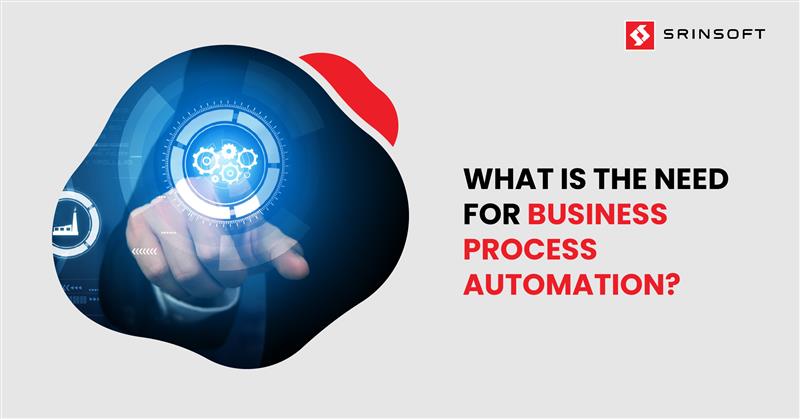
Understanding Business Process Automation
Business Process Automation (BPA) uses concurrent technologies to optimize and automate repetitive and complex business processes with little to no human intervention.
The ultimate intention of incorporating BPA is to make operations more efficient, minimize errors and free up employees to focus on more value-adding tasks.
BPA relies on multiple cutting-edge technologies like Robotic Process Automation (RPA), Workflow Orchestration, process intelligence and cloud Platforms.
Typically, it is deployed in the back end to facilitate core business processes and is combined with enterprise systems such as human capital management (HCM) and enterprise resource planning (ERP).
BPA generally encompasses a set of activities that are spread across multiple departments. It can monitor stock levels, automatically generate purchase orders, update product data and automate tasks such as employee onboarding and financial processing.
Consequently, BPA not only reduces manual intervention and improves accuracy, but it also increases employee productivity and minimize costs. Over and above, BPA helps in standardizing workflows as well as decrease the risk of human error risk.
Importance of BPA
BPA plays a pivotal role in driving efficiency, standardization, and innovation within organizations. The following benefits underscore the importance of BPA.
1. Operational Efficiency
One of the notable benefits of BPA is the enhancement of operational efficiency. BPA can automate repetitive and time-intensive manual tasks which in turn reduces human errors. Automation can therefore speed up processes and standardize workflows for faster cycle times, decreased costs and better output quality.
2. Greater Productivity
BPA also contributes to significant cost savings, as machines handle repetitive tasks without fatigue, leading to greater productivity.
3. Process Transparency and Compliance
By centralizing data through cloud-based BPA tools, businesses can perform real-time tracking of processes while ensuring complete transparency and accountability among teams.
This visibility enables improved collaboration and compliance management by providing visible data trails and ensuring adherence to regulations.
Automation tools also generate auditable records on-demand and they ensure processes are clear, concise and compliant with industry standards.
4. Customer Satisfaction
In addition to efficiency, BPA improves customer service with a faster turnaround time and delivery accuracy – both of which lead to greater customer satisfaction.
Business Challenges that BPA Can Solve for You
Business Process Automation (BPA) has become the go-to strategy for organizations to tackle several business challenges head-on. Here are the five common problems that business process automation can help organizations solve.
1. Integration Issues Between Systems
BPA eliminates system integration challenges by linking even the most disparate applications, including legacy systems and cloud-based solutions. It eliminates data silos, enables seamless data exchange and creates a unified environment with collaboration and improved efficiency.
Organizations frequently contend with integration issues such as system incompatibility, manual data transfer and absence of real-time synchronization. BPA helps overcome these issues by using middleware, APIs, and other integration tools to bridge the gaps and automate data flow between different applications. This eliminates the need for manual intervention, reduces errors and ensures seamless communication between systems. As a result, data can flow freely across various systems in an organization and improve business efficiency.
2. Finding and Rectifying Manual Errors
BPA cuts down human errors to a great extent by automating tasks. Automated systems help with better accuracy, consistency and faster error detection, which can significantly reduce the need for manual checks to identify errors. This ensures that issues are rectified well before it impacts operations.
BPA combined with Robotic Process Automation (RPA) can provide a robust mechanism for error detection and correction for repetitive, data-intensive tasks. Through the use of bots to do data entry, validation, and error detection, RPA can rapidly find errors in processes and fix them with no human intervention required for it to be fixed.
BPA not only increases productivity but also helps employees to focus on other strategic activities, which ultimately enhances the efficiency of operation in its entirety.
3. Compliance and Regulatory Challenges
By automating all end-to-end compliance activity, from documentation to audit reports, BPA ensures that the regulatory standards are always met. This means companies can enforce rules consistently, track changes and generate reports that satisfy industry compliance. This helps reduce non-compliance risk and makes way for ease of audit trails.
By embedding regulatory rules in workflows, BPA simplifies compliance and makes it possible for mandatory documentation and checks to be performed.
BPA also provides real-time tracking and auditing capabilities, automates database queries, and encrypts data to meet standards like SOX, PCI, and HIPAA.
4. Time-consuming Manual Reporting
BPA eliminates the need to report manually, by automatically generating accurate, real-time reports. It captures data from different sources, reflects information immediately as changes take place in the data and eliminates human errors.
BPA also enables the integration with related tasks such as automating data collection or making reports available to stakeholders. This enables real-time, accurate insights to be seamlessly available to decision-makers without delays.
5. High Operational Costs
BPA helps reduce steep operational costs by automating manual, routine tasks and eliminating labour expenses while optimizing resources. Automation also helps businesses to scale without proportional increases in staffing.
Moreover, real-time data analytics provided by BPA can help identify inefficiencies leading to higher cost-saving opportunities as organizations can optimize operations and allocate resources more effectively.
Impact of BPA on Workflow Optimization
BPA plays a transformative role in optimizing workflows. Here is how BPA can have a lasting impact on workflows and aid in optimizing them:
1. Efficient and Effective Workflows
BPA automates routine and repetitive tasks, to remove manual interventions that generally slow down workflows. Once this automation is in place, businesses can realize faster execution of tasks along with increased accuracy and consistency — making workflows more efficient and effective.
BPA utilizes workflow orchestration to seamlessly coordinate tasks across different systems and departments. It serves to automate the handoff from step one of a process to each additional successive step, making execution faster, more accurate and well-organized.
Through the orchestration of these workflows, BPA ensures that each task is performed in the designated order, optimizes resource allocation, and prevents bottlenecks, ultimately leading to smoother, end-to-end process execution with minimal delays.
2. Workflow Transparency and Continuous Improvement
BPA augments workflow visibility by providing real-time and up-to-date insights on the performance of business processes. Automated workflows generate data and reports for teams to monitor progress and identify bottlenecks, delays, and systemic inefficiencies in real-time.
The ability to provide businesses with real time feedback enables them to constantly fine tune workflows and adjust to needs as they arise while enhancing the process over time.
3. Better Cross-Functional Coordination
BPA allows for effective collaboration between departments and systems by integrating different tools and platforms. With automated workflows, communication among departments becomes seamless, silos can be eliminated, and cross-functional coordination can be improved.
For instance, BPA can automate approvals and notifications, reducing delays caused by manual back-and-forth and ensuring that processes move forward swiftly.
4. Cost Reduction and Scalability of Workflows
One of the significant impacts of BPA on workflow optimization is cost reduction. Automation of manual processes can reduce operational costs, decrease expenses related to errors and increase efficiency and save time so that more resources can be directed towards innovation.
Moreover, BPA tools provide scalability, and workflows can be easily adjusted as the business grows without increasing manual effort.
How to Choose the Right Business Process Tool for Your Company’s Needs?
Why BPA is a Game changer for Streamlining Business Operations?
Business Process Automation has become a necessity for every business to achieve its objectives. It is changing the way businesses operate by simplifying operations and making processes more transparent, agile and ensuring compliance with legal and regulatory standards.
The real-time data insights that can be reaped from BPA help in making better decisions, streamline workflows and respond quickly to market changes. Also, due to seamless system integration, BPA breaks down organizational silos enabling smoother cross-functional collaboration and shorter project timelines.
BPA gives a competitive edge by enhancing all-around performance and efficiency, thereby enabling companies to turn their focus on innovation and growth.
It comes with a myriad of benefits, but scaling BPA solutions is also not without its challenges, especially when it comes to implementing the automation in different tasks or synchronizing between automated systems and human workers.
Businesses that can overcome these challenges will find themselves more agile and resilient, better equipped to innovate more freely, while boosting the satisfaction of employees as it frees them up for more meaningful work.



